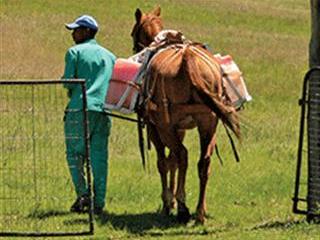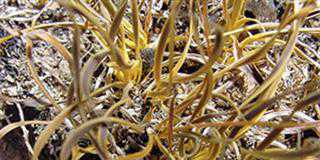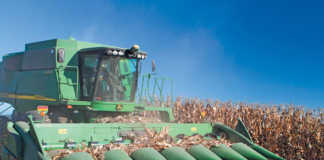
Horses and conservation are Clinton Whitehead’s twin passions. So it is perhaps not surprising that this resourceful farmer has combined them to develop an ingenious solution to a seemingly intractable problem: ridding his land of invasive alien plants.
Since moving onto Glen Hythe near Franklin in KwaZulu-Natal in 2000, Clinton has leased most of his land to a commercial beef farmer.
He has also been combating the alien black wattle (Acacia mearnsii) and silver wattle (A. dealbata) that had invaded his grazing lands and watercourses during the preceding years. Initially, he and his farm workers used the traditional cumbersome knapsack sprayer to apply herbicide to the wattle, both the actively growing thicket and the cut-down stumps. But the hilly terrain made this exercise slow and heavy going, and their work was soon outpaced by the wattles’ rapid regeneration.
“About three years ago I heard about horses being used in the Sierra Nevada in the US to carry spraying equipment into the mountains to control invasive alien vegetation,” Clinton recalls. “So I decided to try it.” Horses are ideal for the purpose, as they can carry more than a human can and for greater distances. In addition, horses are sure-footed on hilly terrain and some are easily trained for this type of work.

Clinton Whitehead
Clinton’s ideal horse breed for the job is the American Quarter Horse because of its stable temperament, low hocks, short cannon bones, low- set tail and good gaskin muscles – all important traits for the safety of the horse and handler while spraying herbicide. “A horse doing this work should have the same handler, ideally wearing the same clothes, to promote mutual trust,” advises Clinton.
Clinton’s spray system is adapted from that used in the US, but much of the equipment has been made and assembled from scratch. Whereas the Americans use carbon dioxide gas as herbicide propellant, Clinton devised and built a miniature system powered by a 12 volt 9Ah battery capable of pumping an impressive 13l/min at 2,5 bar pressure. A standing operator can spray up to 7m above ground level; when seated on a lead horse, this increases to 9m.
“I take care to make the horses as comfortable as possible when they’re packing their loads and working,” he explains. “They must not be injured by the dead weight or equipment. A horse can carry no more than 20% of its bodyweight. Balance is also very important because they are on uneven terrain.”
Optimal fit
To ensure the safety of his seven horses and their handlers, Clinton has designed a pack system and kit to fit each horse’s build and ability. He uses top quality components from respected companies in the West, as cheaper, mass-produced items from the East do not last. And if they fail, they can endanger horse and handler. To prevent saddle sores, a soft saddle-blanket is placed on the horse. This is overlaid with a soft foam pad, on top of which is placed a lightweight but strong adaptation of the half-breed saddle.

To protect the horse from saddle-sores and other injuries, Clinton’s pack system uses a modified half-breed saddle, a soft foam pad and a soft saddle-blanket.
A pannier, supported by wooden bars, is fitted on either side of the horse to carry the equipment and herbicide. The apparatus is designed to distribute the load evenly on both sides. “One side carries the 15kg battery and pump, a 25l container of herbicide mixture and a 20m hose,” he explains. “On the other side is another 25l container of herbicide mixture and a 10l container of herbicide concentrate. During spraying, the pump drains herbicide evenly from both 25l containers to keep the load evenly balanced.”
Experience in the US has shown that a horse-carried spraying system ensures five times more coverage than a knapsack sprayer. “This is a huge advantage when you consider that it’s only possible to spray on days with suitable weather. You need to get as much done as possible in a limited time,” adds Clinton. He sometimes operates with two sprayers and a support packhorse. Experience has shown that even in rough terrain, this arrangement can spray 1 000l of herbicide mixture, provided there has been careful planning beforehand.
Additional herbicide is mixed on-site, and if water to dilute the concentrate is available from a dam or spring, this can help to avoid unnecessary cartage. Despite the capabilities of his system, Clinton believes strongly that for farmers to fight alien vegetation successfully, both the herbicide and spraying need to be subsidised. “Farmers cannot do it alone,” he says.
Asked about crop-spraying aircraft, Clinton explains that there are several reasons why this method is unsuitable for large areas of wattle and other invasive alien vegetation. Aeroplanes cannot apply herbicide evenly and effectively over hilly terrain. They are limited by weather. Spraying is extremely expensive, as is ferrying an aircraft from its home base to the spray site. And finally, the blanket herbicide used in aerial spraying kills alien and desirable indigenous vegetation alike.

Panniers allow each horse to carry a fully-equipped chemical spraying system on hilly terrain.
By contrast, a horse and operator can target individual plants, giving each a thorough spray. It is also far easier and cheaper to use horses and operators for follow-up control spraying. “I’m very conscious of having as low an environmental impact as possible,” stresses Clinton. ”If effective biological agents to control alien invasive vegetation such as wattle were available, I would use them in conjunction with my method.
“In the meantime, I use chemicals that won’t harm animals and don’t apply more than is absolutely necessary. We even use dye in the spray to see where we’ve sprayed.” Clinton offers a complete service to landowners who need help in controlling invasive vegetation on their land. Alternatively, he offers the equipment as ready-to-buy items. He retails the spray equipment carrying system at about R5 500 per horse, the pump system at about R3 500, and a complete spraying unit with saddle, harness and protective overlays at about R13 500 plus VAT.
He also believes that he has a great deal to offer government-funded invasive vegetation control programmes such as Working for Water. “I can give unemployed people in rural areas the skills to tackle the widespread invasive vegetation problem and so earn a sustainable income. I’ve invested a lot in getting this system operational – now I need government to step in and roll it out countrywide.”
The problem with invasive alien vegetation
- Alien plant invaders are a significant and growing threat to ecosystem integrity worldwide. They change the structure and functioning of ecosystems, and harm biodiversity.
- When Working for Water was initiated in 1995, an attempt was made to quantify alien vegetation invasion on a national scale. The programme has since spent R3,2 billion on alien plant control. At 2004 rates of clearing and depending on the species, it would take between two and 83 years to eradicate the most important species, assuming (unrealistically) that no further spread takes place during this time.
- Dense invasive alien vegetation in South Africa was estimated to cover 1,7 million hectares – nearly the area of the Kruger National Park – in 1996. By 2008, this figure had grown to an estimated 1,8 million hectares.
- Controlling invasive species and reducing their impact is crucial in natural resource management. To persuade political sponsors to re-direct resources to priority interventions, ecologists must demonstrate that the value of invasive alien plant control is greater, in terms of protecting ecosystem services and thus underpinning sustainable development, than its value in creating employment in control operations alone.
The above information is condensed from Van Wilgen BW, et al. (2012). An Assessment of the Effectiveness of a Large, National-Scale Invasive Alien Plant Control Strategy in South Africa. Biological Conservation, Volume 148, issue 1 (April, 2012), pp 28-38.
Contact Clinton Whitehead on 083 301 0939, or email [email protected]













